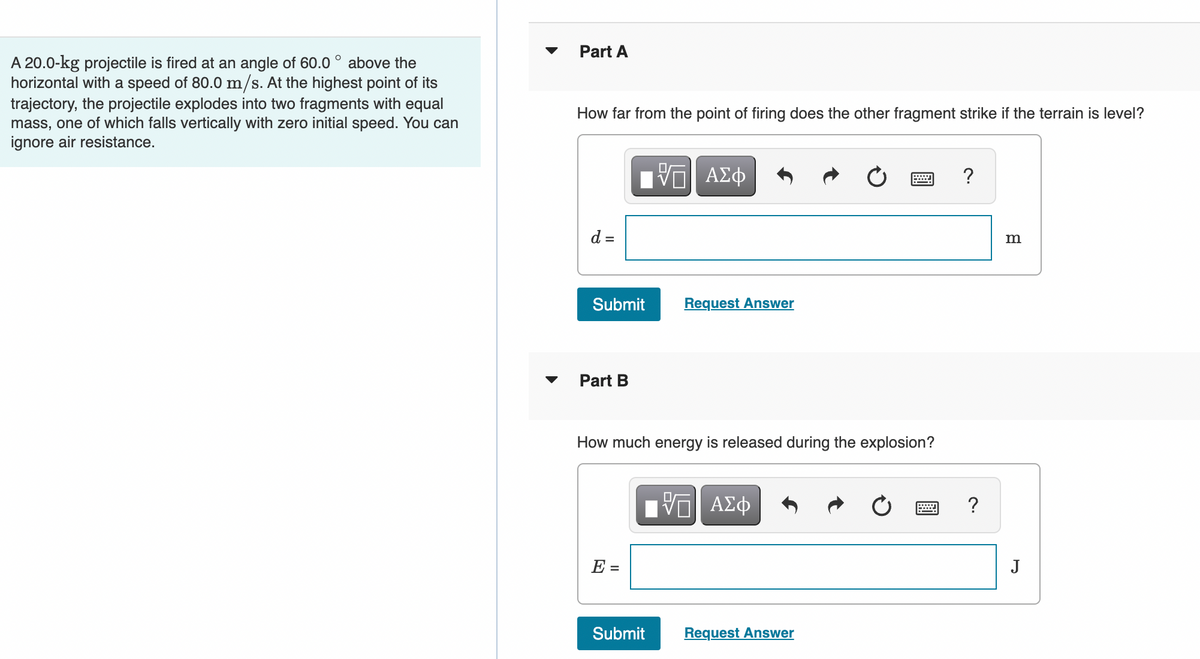Part A A 20.0-kg projectile is fired at an angle of 60.0 ° above the horizontal with a speed of 80.0 m/s. At the highest point of its trajectory, the projectile explodes into two fragments with equal mass, one of which falls vertically with zero initial speed. You can gnore air resistance. How far from the point of firing does the other fragment strike if the terrain is level? ? d = m Submit Request Answer Part B How much energy is released during the explosion? E = J
Part A A 20.0-kg projectile is fired at an angle of 60.0 ° above the horizontal with a speed of 80.0 m/s. At the highest point of its trajectory, the projectile explodes into two fragments with equal mass, one of which falls vertically with zero initial speed. You can gnore air resistance. How far from the point of firing does the other fragment strike if the terrain is level? ? d = m Submit Request Answer Part B How much energy is released during the explosion? E = J
Principles of Physics: A Calculus-Based Text
5th Edition
ISBN:9781133104261
Author:Raymond A. Serway, John W. Jewett
Publisher:Raymond A. Serway, John W. Jewett
Chapter8: Momentum And Collisions
Section: Chapter Questions
Problem 60P: A cannon is rigidly attached to a carriage, which can move along horizontal rails but is connected...
Related questions
Topic Video
Question

Transcribed Image Text:Part A
A 20.0-kg projectile is fired at an angle of 60.0 ° above the
horizontal with a speed of 80.0 m/s. At the highest point of its
trajectory, the projectile explodes into two fragments with equal
mass, one of which falls vertically with zero initial speed. You can
ignore air resistance.
How far from the point of firing does the other fragment strike if the terrain is level?
?
d =
m
Submit
Request Answer
Part B
How much energy is released during the explosion?
ΑΣφ
?
E =
J
Submit
Request Answer
Expert Solution
This question has been solved!
Explore an expertly crafted, step-by-step solution for a thorough understanding of key concepts.
This is a popular solution!
Trending now
This is a popular solution!
Step by step
Solved in 2 steps with 2 images

Knowledge Booster
Learn more about
Need a deep-dive on the concept behind this application? Look no further. Learn more about this topic, physics and related others by exploring similar questions and additional content below.Recommended textbooks for you

Principles of Physics: A Calculus-Based Text
Physics
ISBN:
9781133104261
Author:
Raymond A. Serway, John W. Jewett
Publisher:
Cengage Learning

Classical Dynamics of Particles and Systems
Physics
ISBN:
9780534408961
Author:
Stephen T. Thornton, Jerry B. Marion
Publisher:
Cengage Learning

College Physics
Physics
ISBN:
9781938168000
Author:
Paul Peter Urone, Roger Hinrichs
Publisher:
OpenStax College

Principles of Physics: A Calculus-Based Text
Physics
ISBN:
9781133104261
Author:
Raymond A. Serway, John W. Jewett
Publisher:
Cengage Learning

Classical Dynamics of Particles and Systems
Physics
ISBN:
9780534408961
Author:
Stephen T. Thornton, Jerry B. Marion
Publisher:
Cengage Learning

College Physics
Physics
ISBN:
9781938168000
Author:
Paul Peter Urone, Roger Hinrichs
Publisher:
OpenStax College

Physics for Scientists and Engineers: Foundations…
Physics
ISBN:
9781133939146
Author:
Katz, Debora M.
Publisher:
Cengage Learning

College Physics
Physics
ISBN:
9781305952300
Author:
Raymond A. Serway, Chris Vuille
Publisher:
Cengage Learning